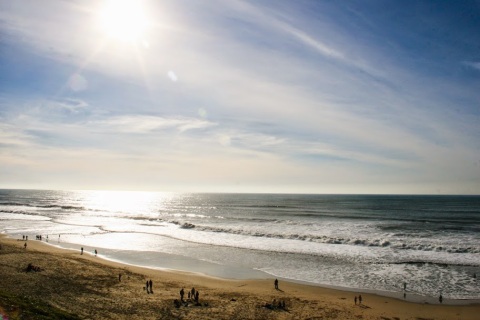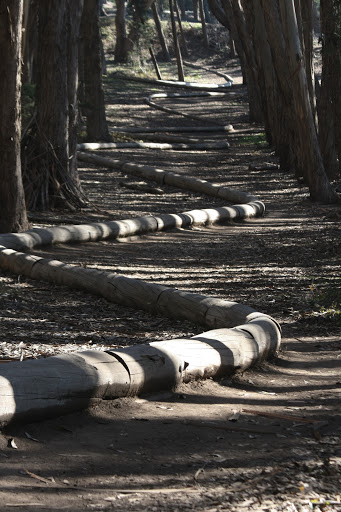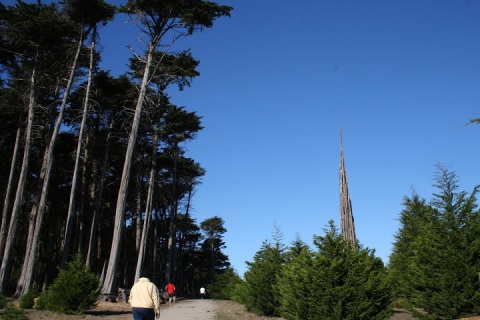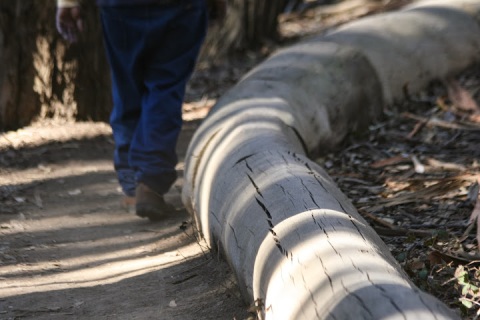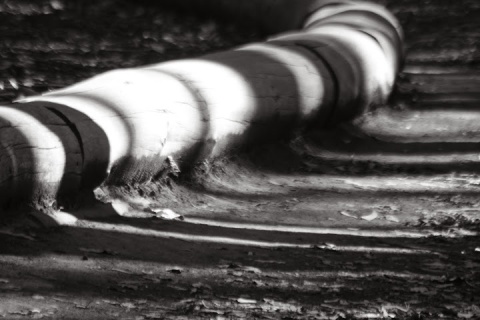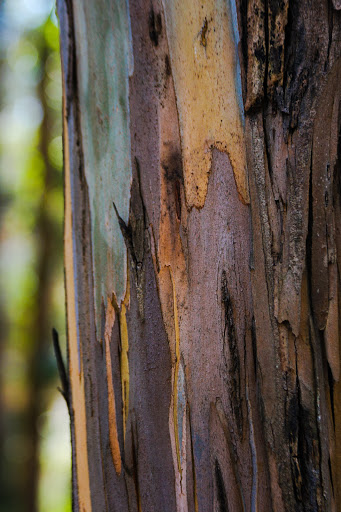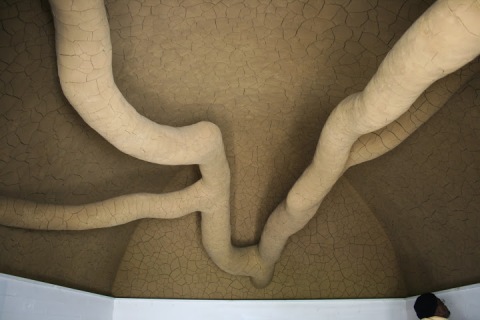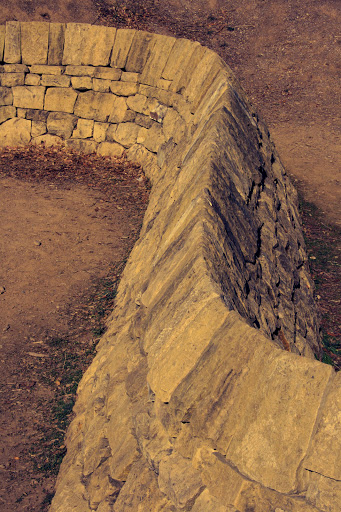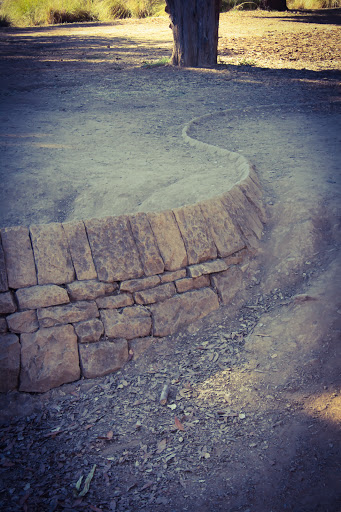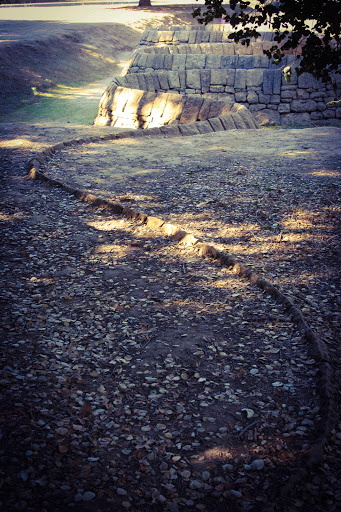Wordless Wednesdays: 12 Views of the Bay Area, California
January 28, 2015
Ruth Asawa: Taking Ordinary Things and Making Them Special
January 26, 2014
“An artist is an ordinary person who can take ordinary things and make them special.”
— Ruth Asawa
Serendipity struck again in my discovery of Ruth Asawa and her sculptures of crocheted wire. As I was doing my trip planning for California, I read about Asawa for the first time at Improvised Life in a post about the New York Times supplement about remarkable people who died in 2013. That very same day, when I mentioned my upcoming trip to one of my library patrons, she said I should be sure to check out the Ruth Asawa sculptures at the base of the de Young Museum tower. Once again it felt like this museum visit was meant to be.
Ruth Asawa was the daughter of truck farmers, and I love how some of her thoughts about making art are seeped in farming metaphors. She said:
“When you put a seed in the ground, it doesn’t stop growing after eight hours. It keeps on going every minute that it’s in the earth. We, too, need to keep growing every moment of every day that we are on this earth. . .”
“Sculpture is like farming. If you just keep at it, you can get quite a lot done.”
At the de Young Museum, Asawa’s sculptures are suspended from the ceiling. The light casts interesting shadows on the walls, creating an ethereal dance between the art and its silhouette on the walls.
Why I Am Inspired by David Hockney and His Art
January 25, 2014
I’ve been reading about David Hockney for the past couple of years. During the year I “adopted” my maple, willow, and horse chestnut trees for observation, I learned about Hockney’s magnificent, oversized tree paintings from his home region of Yorkshire, which culminated in a show at London’s Royal Academy of Arts. (You can see some images of the paintings at this link.) I was enthralled. How I would have loved to see that exhibit. The best I could do was borrow the exhibition catalog, a gorgeous book, from the library.
When I learned that the weekend of our visit to California coincided with the final days of a Hockney exhibit at the de Young Museum in San Francisco, I thanked the Universe for this serendipitous chance to see his work and bought tickets online. The exhibit, called “A Bigger Exhibition,” included his portraits, Yorkshire landscapes, 2013 charcoal drawings, iPhone and iPad paintings, and photo collages. You can tell just from this list of work that Hockney is a prolific artist and an experimenter.
One of the things I admire most about Hockney is that he is like an explorer, discovering new and fun ways to depict what he sees. His color palette is quite bright; his brush and charcoal strokes are energetic. He creates oversized canvases by abutting 4, 6, 8 or more panels and yet the pictures appear seamless.
I especially loved his photo collages, hundreds of photos arranged to give a clear, detailed, large picture of his subject, such as his collage of the Brooklyn Bridge. This is what he says about these photo collages: “Collage is the key to the escape from the old way of seeing. There’s something deep and very profound about the idea of collage, something very true.” (from Hockney on ‘Art’: Conversations with Paul Joyce)
I loved that he set aside his colorful painting in 2013 and delved into black and white charcoal drawings. The ones on exhibit were prints, four times the size of the originals. They were strikingly displayed on the gray museum walls. I have wondered whether I should take time to go back to the basics of drawing in pencil, pen, and charcoal just to get more grounded and proficient. Georgia O’Keeffe did this after art school to find her own point of view and voice. She said, “It was in the fall of 1915 that I decided not to use any color until I couldn’t get along without it and I believe it was June before I needed blue.” (from Georgia O’Keeffe: Some Memories of Drawings, edited by Doris Bry) I found it interesting that such an accomplished and professional artist as David Hockney also took a break to explore art in black and white after years of color.
Thanks to Hockney, I’ve decided that 2014 will be the year I start playing with making art on my iPad.
I love how Hockney continually approaches his work with a fresh eye. He said, “. . . an art that’s not based on looking inevitably becomes repetitious, whereas one that is based on looking finds the world infinitely interesting, and always finds new ways of looking at ourselves.” (from Hockney on ‘Art’: Conversations with Paul Joyce)
If you’d like to learn more about Hockney and see the artist at work, I highly recommend the DVD documentary, David Hockney: A Bigger Picture. My library has it, and now that my husband has seen his paintings, I will have to borrow it again.
Searching for Andy Goldsworthy Art in the Bay Area
January 24, 2014
I have become something of an Andy Goldsworthy groupie. (If you’re a returning reader, you know I’ve written before about the Goldsworthy installations I saw in New York and in France.) When I was planning our trip to California, I did a google search to see whether Goldsworthy has any art in the Bay area — and I learned that he has five pieces including a new one in San Francisco’s Presidio presented in October 2013. That was all the information I needed to set out on a pilgrimage to view his sculptures in their natural settings.
Goldsworthy has three installations in the Presidio. Spire, a 95-foot steeple-like sculpture constructed from 37 large Monterey cypress trunks, was his first and was built in 2008. The Presidio Trust brochure, “Goldsworthy in the Presidio,” says that this artwork “references the architecture of nearby trees but also buildings visible from the site, including the Transamerica Pyramid and church spires. The sculpture is fated to fade into the forest as young cypress trees planted at its base ultimately grow to obscure the piece — like the old forest welcoming the new.”
Goldsworthy’s second Presidio installation (2011) is called Wood Line. It is a curvy, snake-like sculpture made from eucalyptus branches and lies on the sloping ground. The towering eucalyptus trees surrounding Wood Line form a vaulted space like a natural cathedral. This landscape art will deteriorate over time, and the transformative aspect is part of the essence of the piece. I loved the checkered, dappled pattern of the light and shadows on the Wood Line in winter.

Goldsworthy’s newest installation is Tree Fall. It is housed in the tiny historic powder magazine building, so it reminded me of some of his pieces in the refuges along the Goldsworthy hiking trail in France. The Presidio Trust describes this piece as follows: “While Spire articulates the space into which trees grow and Wood Line investigates the relationship of a tree to earth, Tree Fall explores what occurs beneath the ground.” This artwork is comprised of a section of tree that seemingly grows out from a clay-covered ceiling. There is a sense of being underground like a tree root.

The next Goldsworthy installation we saw was in the entry courtyard of the de Young Museum in Golden Gate Park. It is called Drawn Stone, and it is a meandering fissure in the paving stones and stone benches. It seemed to represent a fault line, appropriate to the earthquake-prone city. My husband and I walked right past it, oblivious to its presence until it was pointed out to us by the staff.
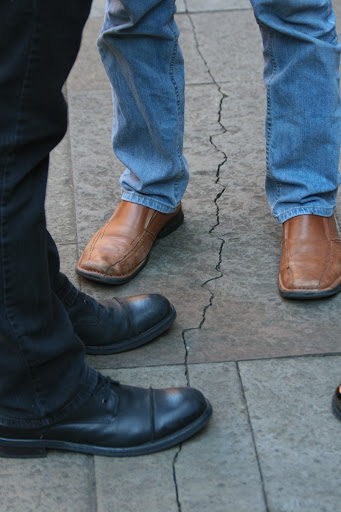
The fifth Andy Goldsworthy installation in the Bay Area is on the Stanford campus. It is called Stone River, and is another of those serpentine sculptures that so captivate the artist. This sculpture is a wall of stone, curving like a snake, and situated in a depression in the earth. The stones were shaped from the debris of university buildings damaged in the 1906 and 1989 earthquakes.
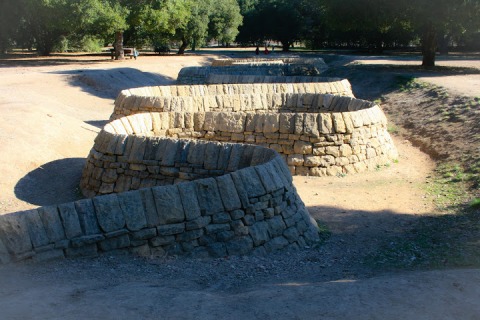
My California Road Trip
January 23, 2014
My husband and I just returned from a short vacation in California. It was a wonderful sunny break from our gray Seattle winter. Mark Twain said, “The coldest winter I ever saw was the summer I spent in San Francisco.” For this trip, we could say, “The warmest summer I ever saw was the winter I spent in San Francisco.” We had blue skies every day, and the temperatures reached the low 70s, warm enough to wander about in a tee shirt and fleece vest. We left our winter jackets in the car.
I will be writing about our California experiences over the next several days. Today’s post showcases photos I took on our walk across the Golden Gate Bridge. When this bridge first opened in 1937, the San Francisco Chronicle called it a “$35 million steel harp.” It spans the 1.7 mile Golden Gate Strait and connects San Francisco and Marin County. At 4,200 feet in length, it is currently the ninth longest suspension bridge in the world.



